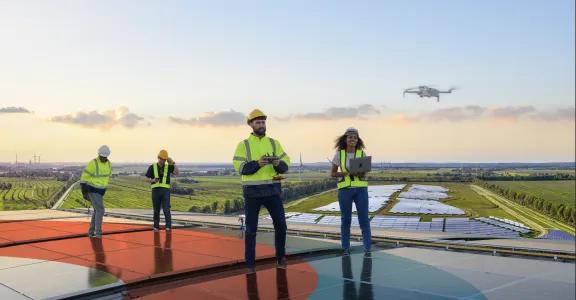The key role of people in the Factory of the Future
More than fruit baskets and fitness: how good leadership makes the difference
With the Make The Future programme, Agoria and Sirris guide companies step by step toward recognition as a ‘Factory of the Future’. This process focuses on seven transformations that are essential for this recognition. In this series we elucidate each transformation together with an expert. This time Robrecht Janssens discusses the Human-Centred Organisation transformation.
Robrecht Janssens, Labour Organisation Expert at Agoria
A factory is not just about robots
Hello Robrecht, what does the Human-Centred Organisation transformation involve?
Robrecht: When it comes to factories of the future, the general public often immediately thinks of robots. This is only part of the story. Videos of warehouses where little AGVs take on order processing distort the picture, because logistics and production are lumped together. In reality, in our manufacturing industry, we see that many human operations are still needed. Therefore we at Agoria and Sirris are convinced that people will have a place in the Factories of the Future too, even if that will be different than in the past.
In our vision, a Human-Centred Organisation is an organisation that tries to provide a challenging, interesting and varied job for those production employees, with as much added value as possible. That can be for example process control tasks, but also specialised activities or customised work that is harder to automate, or for which changeover of standard machines is too complex.
In Belgium we’re firmly committed to employees, for one good reason. Belgium has already struggled for decades with a handicap when it comes to labour costs. Our productivity is more and more under pressure. So attention to the place of employees in the industrial narrative has come into the picture. We’re convinced that in an industrial future for Belgium there is also room for employees, but in a different role, with different competences.
Six perspectives for a successful transformation
With our Human-Centred Organisation transformation we approach those challenges in a structured and thematic way from six perspectives:
- Tasks and assignments: How do we increase the added value of human activities?
- Personal and professional development: How do we ensure that employees are part of the evolution?
- Health, safety and wellbeing: How do we eliminate physical and mental overload?
- Management and leadership: How do managers ensure clear direction and involvement?
- Transparency about vision and strategy: Do employees understand how they contribute to the future?
- Company culture and values: Are shared values a catalyst for motivation and innovation?
How does the transformation proceed in practice?
Robrecht: In the Factory of the Future the operational process is the focus, but employees cannot be a passive object. In workshops and support sessions, we help companies make processes more efficient, flexible and customer-oriented, with attention to safety and quality.
Jobs evolve due to digitalisation and automation. Operators are more and more often taking on a coordinating or analytic role, which requires new skills and makes active involvement in change necessary.
The result is sometimes surprising. It can for example happen that jobs go from being purely operational to more coordinating. It can be that machines in an integrated production cell will communicate with each other and an operator will have more of a coordinating role, or will be responsible for preventive maintenance. And that means again that you have to use your head, to understand what is going on. Experience is a major added value in this, to understand what machines are doing, and to analyse whether the things that are happening are the right things. So the job evolves, but so do the competences.
That means that your employees must keep their wits about them in any event, otherwise digitalisation and automation won’t achieve much. Today products are often made in countless variants. Customers love so-called customisation, but changeovers take time, and the role of efficient and transparent planning then becomes crucial, to know which variant is to be produced at what time. We see therefore that the manufacturing companies that we believe can establish themselves in Belgium for the long term are those where the operators first and foremost turn on their heads, even before they turn on the machines.
How do you ensure that employees are part of the process?
Robrecht: Transparent communication and involvement ensure that employees don’t see change as a threat, but as an opportunity. Successful companies clearly explain to their employees:
- Why: What is the long-term vision? Where do we want to go with the company? What impact do we want to make as a company?
- How: Which processes are then important and take precedence? Which performance indicators are real key indicators? (Small tip: try to reduce that to 3, the essentials that an employee can really grasp.)
- What: Which actions and operations do I have to guarantee? Where can I ensure that things go smoothly? Which processes do I manage?
Evolution, not revolution
So it’s about change management?
Robrecht: Yes, but let’s not call it that, because the term ‘change’ in itself often provokes resistance. Communication and leadership are more important levers. Companies that learn the added value of explaining things well to employees usually succeed in getting them to move step by step in the right direction. However, just because you apply a project-based approach doesn’t mean that it necessarily goes smoothly. People don’t like change, and you can’t blame them for that.
We’re not made for revolution, but for evolution. So explain thoroughly to your employees why certain changes are happening, how the operational process is structured, and what that will mean at the level of their job: what tasks they will have in the future and what competences they will need for them, but also how you are going to guide them in developing them.
And so you have to involve your people early in the process?
Robrecht: Exactly. You have to dare to ask operators how they approach things practically; what do they do and what do they not do? What does the job look like today, and what are the various activities? You must know what skills and competences are demanded for the tasks you want to introduce; do you need to work on leadership or on internal communication?
In short, you want to combine as many perspectives as possible to set to work in a multidisciplinary way. And it’s true that an engineer probably grasps certain things faster than an operator, especially with regard to improvements. Because you can of course install data sensors on your machines so that operators will make better decisions, but if you can’t get them to use their tablet, for example, because you’re lacking change management, internal communication and leadership, then nothing will come from your breakthrough.
Leadership is key?
That’s the fourth aspect in this issue, together with internal communication. There are often more managers in an organisation than leaders, while it should be just the opposite. Leadership is about influencing others, and I hope that a project engineer can do that too, just like for example a maintenance technician. Because if you succeed in explaining to operators that it would be advantageous if they did preventive maintenance, then you need fewer repairs. Influence and impact like that is leadership too.
Human-Centred Organisation is very often a matter of trickle-down action or mindset in which each level in a company learns from the level that manages them. So step one is ensuring that those in the management team are aligned with that sort of thinking, that the plant or production manager also sees that the factory of the future will be one with employees, and that that can be a catalyst for change. That they can be a driving force for the changes you want.
Three practical tips for a Human-Centred Organisation
What three tips would you pass along for working on a Human-Centred organisation?
Robrecht:
- Self-reflection: How people-oriented is your organisation?
- Involve employees early: Ask about their experiences and ideas.
- Invest in communication: Transparency ensures trust and involvement.
Conclusion
Companies that are committed to a Human-Centred Organisation build a strong, innovative future. Employees who are involved help make the company more flexible and competitive.
Read about the other transformations of the Make The Future programme:
Make the Future: Your Pathway to a Factory of the Future >
Transforming to Digital Factory >
Transformation to Eco Factory >
Discover the Make the Future programme!
Want to know more about what Make the Future can do for your business? Find out here how this programme from Agoria and Sirris can help you transform your manufacturing company into a sustainable and innovative market leader.
For more information, contact our expert Robrecht Janssens, or arrange a no-obligation appointment for an initial analysis of your business.



